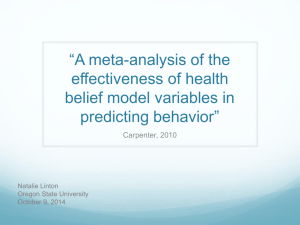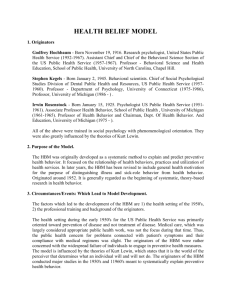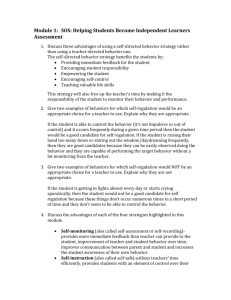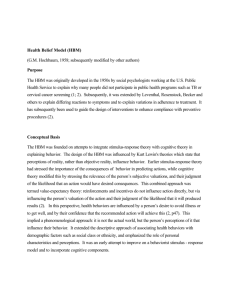Sample writting assignment
advertisement
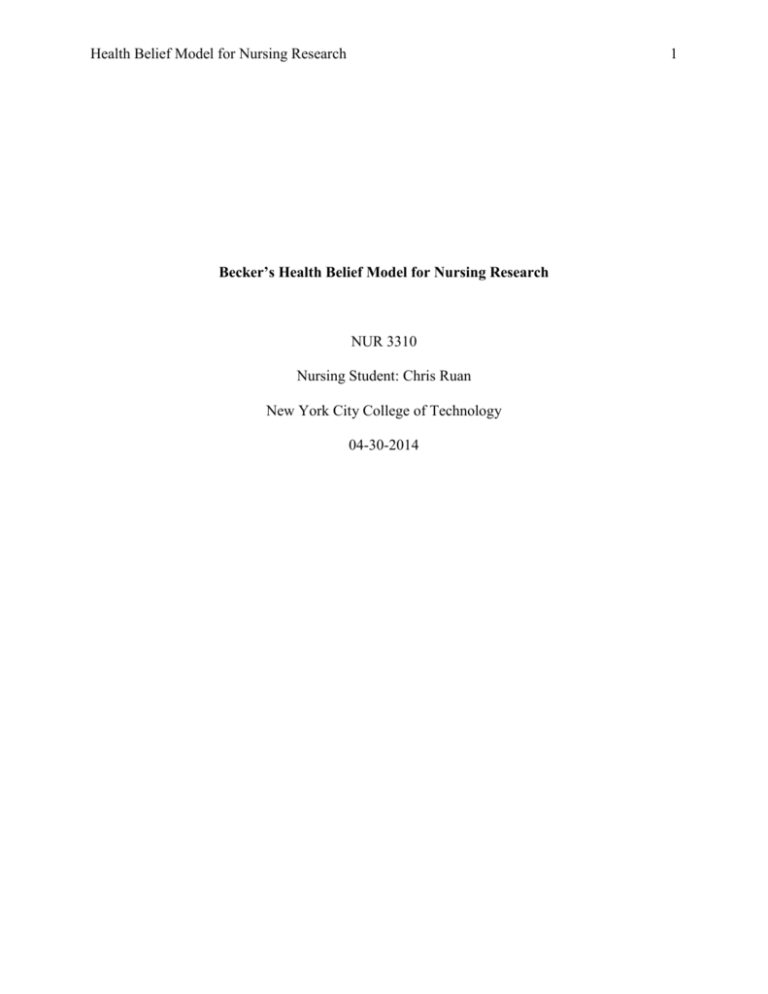
Health Belief Model for Nursing Research 1 Becker’s Health Belief Model for Nursing Research NUR 3310 Nursing Student: Chris Ruan New York City College of Technology 04-30-2014 Health Belief Model for Nursing Research 2 Becker’s Health Belief Model for Nursing Research A study with higher level of quality typically achieves a higher level of conceptual integration. To achieve higher level of conceptual integration, a series of studies had been performed and suggested that some key health beliefs provide a significant framework to explore a variety of long and short-term health behaviors. The researchers make the research questions fit the method that they chose to carry out the study and those questions are consistent with the existing evidences. The method also serves as a base for them to offer conceptual rationales for expected outcomes. Nurse researchers have used both nursing and non-nursing frameworks to provide a conceptual context for their studies. Choosing a proper theory or model for a research is essential to achieve a better outcome. The model I chose for the nursing research journal is Becker’s Health Belief Model (HBM). Becker’s Health Belief Model (HBM) is a framework for explaining people’s health related behavior, such as health care use and compliance with a medical regimen (Pilot & Beck, 2014). According the model, health-related behavior is influenced by a person’s perception of a threat posed by a health problem as well as by the value associated with actions aimed at reducing the threat (Becker, 1976). • Development of the Health Belief Model (HBM) The Health Belief Model was first developed in 1950s by social psychologists Rosenstock, Hochbaum, and Kegels. Rosenstock first attributed the HBM in response to the failure of a free tuberculosis (TB) health-screening program carried out by Hochbaum. Since then, the HBM has been adapted to explore a variety of long- and short-term health behaviors, including sexual risk behaviors and the transmission of HIV/AIDS (Perawatunkla B. 2012). Health Belief Model for Nursing Research • 3 Structure of the HBM Two factors of individual’s representations of health and health behaviors are the focuses of the Health Belief Model. They are threat perception and behavioral evaluation. There are two key beliefs in the threat perception, which are the anticipated severity of the consequences of illness and the perceived susceptibility to illness or health problems. There are also two key beliefs in the behavioral evaluation. One is the perceived benefit and the other one is perceived barriers. The model also proposes the cues to action would activate that readiness and stimulates overt behaviors. In the later versions of the model, an addition to the HBM is the concept of selfefficacy. Therefore, there are six specific independent variables, which can be used to explore and predict people’s health behaviors. • Scope and Application The Health Belief Model has been applied to a broad range of health behaviors and subject populations. Three large scopes of HBM have been identified (Conner & Norman, 1996): 1) Preventive health behaviors, which including health risks and health promotion methods. 2) Sick role behaviors, which also refer to behaviors of compliance. People follow the recommended medical regimens after the illness diagnosed by professional personnel. 3) Use of clinic offices, which includes visits to doctor’s office for any health problems. I chose two articles below and will give more details of them below. “Sick role behaviors” was applied to one article and “Use of clinic offices”, which includes seeking social support was applied to another article • Samples of Journal Articles used HBM I chose two journal articles that used the HBM theory in their researches in order to gain more general idea on this model. In these two articles, the authors used the HBM as the Health Belief Model for Nursing Research 4 framework of their researches to enable a better understanding of the reasons some individuals adhere to their treatment regime. The article #1 I chose is “Akey, J., Rintamaki, L., Kane, T., (2012), Health Belief Model deterrents of social support seeking among people coping with eating disorders. Journal of Affective Disorders 145 (2013) 246-252.” Article #2 is “Jones, C., Smith, H., Frew, A., Toit, S. Mukhopadhyay, and Llewellyn, C., (2013), Explaining adherence to self-care behaviors amongst adolescents with food allergy. British Journal of Health Psychology (2014), 19, 65-82.” Both articles used the HBM as a guiding framework in their study of factors to determine that one person will likely engage in disease prevention and health-promoting activities. In article #1, the authors used qualitative descriptive design. This kind of design is rooted in a grounded theory approach throughout the data collection process and provides description about any naturally occurred phenomenon without any interventions and treatments. It usually occurs in natural environment. It is referred to any research that utilizes an existing data or non-experimental study with a preconceived hypothesis. The subjects were interviewed through face to face or by calling them over the phone using a sets of questions which included the reasons they forego seeking social support that may help them cope with their eating disorders. In article #2, the authors used quantitative cross-sectional design. The researchers collected the data at one point in time and data were collected concurrently on the independent and outcome variables (the psychological factors associated with the HBM and the adherence to self-care behaviors with food allergy). The goal of the first article is to identify some specific barriers and deterrents perceived by individuals diagnosed with eating disorders to see if they will seek any specific social support for eating disorder. The authors thought it is necessary to carry out this research because the eating disorders have the highest mortality rates than any of the psychiatric disorders. By understanding what can prevent people with eating disorder from Health Belief Model for Nursing Research 5 seeking or accessing social support can help them significantly manage these disorders and to achieve critical improvement. The goal of the second article is to identify reasons for adolescents with food allergy-induced anaphylaxis to adhere to self-care behaviors. Food allergy affects approximately 2.3 of adolescents in the United Kingdom (Pereira et al. 2005) and the prevalence is increasing (Centers for disease Control and Prevention, 2011). Food allergy is the leading cause of anaphylaxis in non-health care settings (Sampson 2004). Beside the facts mentioned above, the authors thought that the interventions designed in the study to elicit personal barriers to the adherence and to address perceptions of severity and the unpredictable nature of symptoms may be more effective in improving adherence to self-care behaviors than current interventions. When determining the eligibility criteria to define the population characteristics, article #1 only gave a general idea about who were included and how they were recruited in the study. It only mentioned: “34 men and women living with eating disorder were recruited and interviewed”. It lacks of any specific information on who was not qualified and who should be excluded from the study. Participants need to be assured that their participation, or information they provide, will not be used against them in any way. Except the participants signed the consent form, the authors did not underline any protection for the participants. Because of the number of respondents is small and because rich descriptive information is presented, qualitative researchers need to take extra precautions to safeguard participants’ identity (Pilot & Beck, 2014). In comparison to article #1, the authors in article #2 gave comprehensive information on how to define the eligibility of the population. Adolescents between the ages of 13 and 19 years with prescribed adrenaline auto-injector (AAI) were eligible for participation. But any of those who were unable to read or write, or if they were not English speaking, were excluded from the study. Also, beside every participant signed the consent inform, for any participants aged between 13 to 15 years old, Health Belief Model for Nursing Research 6 their guardians must receive a copy of information sheet. The researchers also obtained ethical approval from the National Health Service South East Research Ethics Committee. After each of the research was performed, they got significant results. The main result from the first article is that all 34 participants reported the reasons why they don’t want to seek social support for managing the eating disorders were against the five specific independent variables of the HBM model. These five variables do not include the “Cues to Action” that mentioned previously. This study added the importance of daily management of eating disorders in nonclinical settings to better understand and improve the management of eating disorders, as it may provide further details on the etiology and therapeutic treatment of these disorders when comparing to previous researches, which were mainly focused solely on the clinical treatment of eating disorders. The main result from the article #2 is one hundred and eighty-eight food-allergic adolescents completed the questionnaire. 21% of the explained variance in adherence behaviors accounted from the independent variables of the HBM, specifically the variables of perceived severity and barriers. Perceived barriers seem to the strongest predictor of behaviors in comparison with all other independent variables of HBM. The results support the findings from Carpenter’s metaanalysis of 2010 examining the effectives of HBM variables in predicting behaviors. Carpenter’s 2010 meta-analysis reports that perceived barriers were found to be more effectively in predicting behaviors when the recommended behaviors involved the prevention of a negative health outcome rather than compliance with treatment. It also reported that perceived severity was found to have better predictive ability when the behavior was related adherence to prescription medication rather than adherence to preventive health behaviors. In the article #1, the researchers gathered all the data and framed them against the independent variables of HBM. Through consensus, the researchers then determined where each of the deterrent categories Health Belief Model for Nursing Research 7 among the HBM five independent variables to be placed. They found each of the deterrent categories fits neatly into the larger model. A descriptive scheme was developed to depict through this process to identify how participants to perceive a) an eating disorder’s severity, b) susceptibility to negative effects from an eating disorder, c) benefits of social support, d) selfefficacy in accessing social support, and e) barriers to social support each deter social support seeking among people living with eating disorders. It did not use the cues to action variable. By using the HBM framework, the researchers identified a series of barriers and deterrents that prevents patients from seeking social support. In article #2, researchers used the HBM questionnaire included a total of 32 items measuring the five independent variables-perceived severity (7 categories), perceived susceptibility (3 categories), perceived benefits (3 categories), perceived barriers (10 categories), and cues to action (9 categories). All of those 32 items were scored on a 5-point scale to get the data. It did not use the self-efficacy variable. • Personal opinion on the HBM framework From the two articles I chose for analyzing the Health Belief Model, we can see that it helps explain why individual patients may accept or reject preventative health services or adopt healthy behaviors. These useful checklists of issues needed to be addressed in health educational and promotion campaign. It can be served as an important tool to figure out what problems that patients are facing. We as health care givers can provide more effective and efficient care to patient from issues we had identified by using the Health Belief Model. One of the major weaknesses is that this model focuses on specific individual behaviors and does not take social, environmental influences and the role of emotion in decision-making into account. In article #1, the social factor may be his friends with eating disorders influenced the patient. In article #2, an adolescent may not adhere to self-care behaviors because he was Health Belief Model for Nursing Research 8 active in social interactions and ate a lot outside with his friends. This can alter his eating habits and affect his adherence to self-care behaviors. Unfortunately, the barriers have immediate, consistent effect while the benefits are long-range. From this point, it is easy to see why it is so difficult to get patients to change behaviors even with professional interventions. In article #1, patients knew they had an extreme fear of weight gain or they would have excessive exercises and fasting after binge eating. But the benefits would be a long-term goal and this could prevent them from stopping the psychological disorders and seeking social support. We can design any appropriate interventions to help them when we know what aspects of the Health Belief Model patients accept or reject. If a patient is unaware of his risk factors or barriers, for an example, we can provide patient with the information collected through research by using the HBM. Or if the patient is aware of the barriers or risk factors, we can focus our efforts by teaching him how to use other effective methods to overcome the perceived barriers when he feels the behaviors that needed to be changed are overwhelming or unachievable. In addition to any approaches addressing dysfunctional beliefs and behaviors, modifying emotional responses and then towards interventions is also important. As I said above, the Health Belief Model provide useful framework for guiding a research. An alternative model may reveal other important findings due to their conceptual differences. Before we decide using the HBM in our research, it is critical for us to justify which model that would lead to elicit more important information that can help people improve their quality of life. Health Belief Model for Nursing Research 9 Reference: Polit, Denise, F., Tatano, Cheryl, Beck (2014). Essentials of Nursing Research. Philadelphia: Walters Kluwer, Lippincott Williams & Wilkins. Conner, M. & Norman, P. (1996). Predicting Health Behavior. Search and Practice with Social Cognition Models. Open University Press: Ballmore: Buckingham. Cambridge Handbook of Psychology (2007). Health and Medicine. The health belief model1 Becker, M. (1976). Health Belief Model and personal health behavior. Thorofare: Slack, Inc. Perawatunkla B. (2012). Community nursing: education and promotion. Retrieved from http://perawatunklab.wordpress.com/author/perawatunklab/

